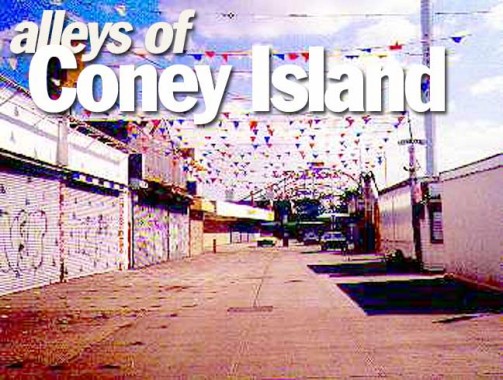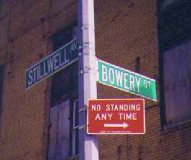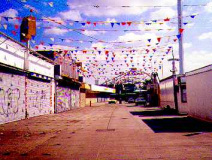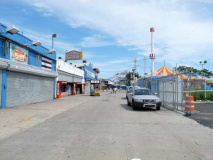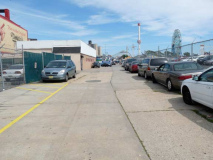Believe it or not, your webmaster does enjoy the usual pleasures of Coney Island. The mermaid parade, a dog at Nathans, and a July stroll on the boardwalk are all parts of my usual summer repertoire. But Coney Island is a land inhabited by many ghosts. Strange little walkways and alleys with unusual names abound, and I spent an October day here …
Bowery Street
The ancient, and now demolished, Thunderbolt roller coaster once shadowed Coney Island’s Bowery. Dig those cotton candy clouds.
There’s more than one Bowery in New York City. This one goes back to George C. Tilyou, who in many ways made Coney the mecca that it truly was from the 1880s all the way to 1964, when his Steeplechase Park closed.
From Jeffrey Stanton’s Steeplechase webpage:
In 1882 when [Tilyou] was twenty, he and his father Peter built Coney Island’s first theater, Tilyou’s Surf Theater, along an alley that bisected the walk streets between Surf Avenue and the ocean. Performers like Weber & Fields, Sam Bernard and Pat Rooney appeared on its vaudeville stage. To make sure that audiences could easily make their way through a cluster of lager-beer saloons, clam bars and bathhouses, they paved the alley with wooden planks and called it Ocean View Walk. Since it was reminiscent of a notorious Manhattan street that had become synonymous with theatrical bright lights and immoral gaiety, it was dubbed “The Bowery” by Mrs. Newton, the mother of [Tilyou associate] McKane’s chief lieutenant. The name stuck.
Concrete replaced wooden planks long ago.
A confession. The Bowery is not usually this barren. From June to September, it’s packed with kids, parents and tens of thousands of others escaping the summer heat. Your webmaster is not trying to run down the Coney of today. Coney remains a summer mecca and always will be one. But the past continues to entrance. As we’ve seen recently with the Thunderbolt recently, one by one its landmarks disappear. Every year.

Forgotten Fan Don Brunjes sent me a then-and-now montage of Bowery Street that shows the only extant structure (blue arrow) that survived from the turn of the last century, on the corner of Stillwell Avenue. The structure is the old Henderson’s Dance Hall, built by Fred Henderson in 1899. The building was gutted in a 1903 fire, rebuilt, but then cut back in 1923 when Stillwell Avenue was widened. Until 1984 the building housed Lily Santangelo’s House of Wax.
Wouldn’t you love to jump in a time machine and spend an August afternoon at the Coney of 1915? Slurp the clams, pound the beers and drink up the balmy breezes. Just bring a straw hat. Go there today and see what the years have wrought. Tilyou is cursing or weeping, wherever he is.
Henderson Walk
In Coney, ancient trolley poles that haven’t served that official function since the 1940s make dandy places to hang signs. Hefty Coney breezes or indolent vandals have bent the sign.
Long ago, these poles received a sporty red, yellow and blue paint job, which they have boasted ever since.
Henderson Walk, between Surf Avenue and the Bowery just west of Stillwell, bordered the old Surf Hotel, which, depending on what story you heard, still had tenants in the early to mid 2000s. I didn’t ring the doorbell. The hotel was demolished in early 2011.
Some maps show it as Stratton-Henderson Walk. It is likely named for Fred Henderson who owned the abutting property.
By 2011, Henderson Walk had been virtually eliminated, as had all trace of Fred Henderson and his dance hall. The alley that ran between the Shore Hotel and the dance hall has no reason to exist any more, and was filled with construction equipment that summer.
Jones Walk
Jones Walk stretches between Surf and the boardwalk between West 10th and West 12th Streets. It has several arcades along its length and leads directly to the world famous 1920 Wonder Wheel, till recently the world’s biggest ferris wheel.
At right, under the gates, is the oldest building still standing in Coney Island, the Union Cigar Building which dates to the 1880s.
By 2011 Jones Walk had held up well, since it is still lined with amusements, some of which were alarmingly shuttered in the summer. The Union Cigar Building was still there.
Schweickerts Walk
By the way, my spelling, Schweickerts, is correct. Never pay attention to the Department of Transportation spelling.
Just east of Nathan’s Famous, which opened in 1916,Schweickerts Walk serves as the outdoor plaza of the world renowned frankery.
A lot of people don’t know it but the Coney Nathan’s has a much bigger menu than the franchised Nathans found all over NYC. There’s a large seafood menu and frogs’ legs are even available.
Kensington Walk
Kensington Walk is under the weeds.
Note the now-demolished Thunderbolt. Ruins of an adjoining amusement center, Playland (no relation to the also-disappeared Rockaway Playland) can also be seen here, unless they too have succumbed to the wreckers’ ball.
Did I mention ghosts?
Kensington Walk, from Surf Avenue to the boardwalk near West 16th Street, used to be the eastern boundary of George Tilyou’s Steeplechase Park. Steeplechase disappeared after the summer of 1964, and Kensington Walk has been gradually disappearing since then. These days it’s under weeds and cordoned off by a chain link fence.
In the spring of 2001, the Brooklyn Cyclones, a minor-league A team affiliated with the New York Mets, began play in a brand-new stadium built on the site of the old Steeplechase. The ancient Thunderbolt faced this site, and while I have a letter from the NYC Department of Housing Preservation and Development stating that the Thunderbolt’s owner had failed to prevent it from deteriorating to the point of collapse, therefore necessitating its demolition, Your webmaster suspects that the Mets, or the mayor, or both, did not want this so-called eyesore ruing the view from the new stadium and it was duly demolished. But that’s not the official word.
Let’s continue westward in search of more alleys…
Highland View Avenue
And now we come to the strange case of Highland View Avenue, which runs all of one block between West 22nd and West 23rd Street just north of the boardwalk. It’s unusually named since there are absolutely no hills or highlands nearby. Perhaps a clever real estate developer, building a tall apartment building that no longer stands here, gave it that name. These days Highland View Avenue faces weeds on each side.
I’m told that Coney Island does face the New Jersey highlands…so maybe the name is appropriate, after all.
Sea Place
Located between West 32nd and West 33rd Street, Sea Place once fronted the Lincoln Baths bungalow colony, which existed before the boardwalk was built. The bungalows extended to the water’s edge and were built on pilings.
The last remnants and ruins of the Lincoln Baths colony can still be found, but the weeds have completely taken over Sea Place.
Sources:
Coney Island Walking Tour, Charles Denson, 1998 Dreamland Press
